Kevin McCarthy has written several popular books focusing on African American history and culture in Florida.
From 1969 to 2005, McCarthy taught at the University of Florida. He has written or edited 35 books, 30 of them about Florida. His books include “The Book Lover’s Guide to Florida,” “Florida Lighthouses,” “Thirty Florida Shipwrecks,” and “Twenty Florida Pirates.”
Despite his diverse interests, the author keeps returning to the topic of black history in the Sunshine State.
“I bought a pup tent in 1976, camped my way around the state of Florida, just to learn as much as I could about this remarkable state I was going to call my home for the rest of my life,” says McCarthy. “I began to go to African American churches, I went to hundreds of cemeteries, sites around, went to the archives in Tallahassee, just for my own information about what the African American history was like in this state. I was surprised to find that we have a lot of personages in our history of African American decent that really ought to be better known.”
McCarthy’s book “African Americans in Florida,” co-authored with Maxine Jones, profiles dozens of interesting people including educator Mary McLeod Bethune, poet James Weldon Johnson, and civil rights activist Harry T. Moore.
“I think in the top five would be Zora Neale Hurston,” says McCarthy, citing her activities as a folklorist and anthropologist, in addition to her better known work as a novelist. “She used to go out to turpentine camps and to logger camps, interview people, and she began to accumulate lots of information about the folklife among African Americans.”
African American history in Florida goes all the way back to the first Spanish contact. People of African descent were on board all of the Spanish ships that came here, making black people among the first non-indigenous people to set foot in Florida.
“One of the first expeditions that came to Florida had an African named Estevanico,” says McCarthy. An expedition of 300 men under Pánfilo de Nárvaez was reduced to 80 as they unsuccessfully attempted to establish a settlement in Florida. Estevanico was one of only four who survived a voyage on makeshift rafts in an attempt to get to Mexico. “He was not only a strong person to survive the terrible ordeals they had, but he made a significant contribution to helping the Spanish discover what it was like in the southeast.”
Educators have found it useful that the book “African Americans in Florida” has a companion Teachers Manual.
“I met with school officials to make this book as applicable as possible to middle and high school students, and help teachers use it,” says McCarthy. “My daughter is a fourth grade teacher in Orlando, and she doesn’t have a whole lot of time to prepare brand new material every single day.”
Another one of Kevin McCarthy’s most popular books is “African American Sites in Florida.”
Fort Mose, established in 1738, is known as the first legally sanctioned black community in what is now the United States. Eatonville, established in 1887, is the oldest incorporated African American municipality entirely governed by African Americans. McCarthy identifies many other important historical sites.
“Fort Jefferson, down in the Florida Keys, the largest masonry structure ever built in this country, was built by slave labor,” says McCarthy.
“In Daytona Beach, Jackie Robinson broke the color barrier in professional baseball. If you visit Daytona Beach today, you will see a statue of Jackie Robinson outside of Jackie Robinson ballpark, where spring training games are still played. Robinson is holding the hands of two youngsters, one black, one white, clearly speaking to them. Behind the statue there is a wavy wall made of stone.” McCarthy says the shape of the wall symbolizes the ripple effects that one person can have on history.
In his book “Black Florida,” McCarthy continues his study of African American history and culture looking at the Rosewood Massacre, and civil rights demonstrations in Tampa and Tallahassee. He takes readers to Pensacola, the home of Daniel “Chappie” James, America’s first black four star general, promoted in 1975.
“Almost every major city in Florida has some significance in African American history,” says McCarthy.
